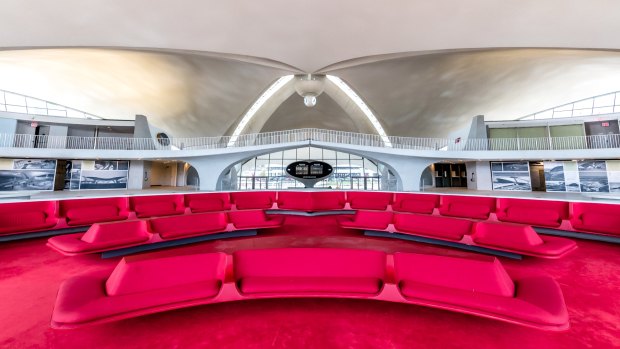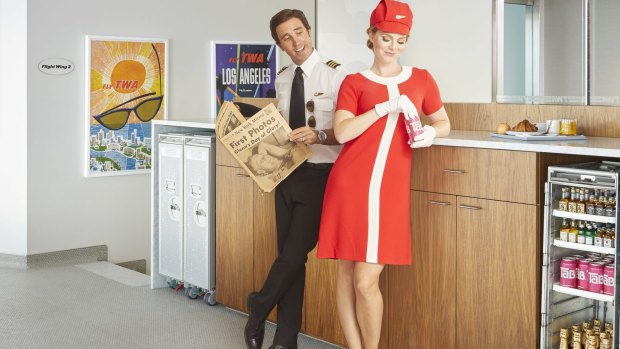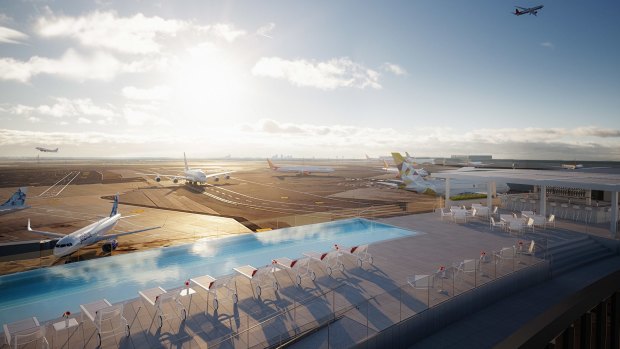This was published 4 years ago
TWA Hotel at New York's JFK airport is a retro joy like a Mad Men theme park
By Philip Kennicott
Eero Saarinen's 1962 TWA terminal at what is now John F. Kennedy International Airport has always been about selling a fantasy.
When it opened, it promoted the vision of its corporate patron, Trans World Airlines, for what air travel could become: an opportunity for the swelling middle classes to explore the world, to partake of the freedom, mobility and some measure of the glamour of travel that had previously been reserved for the well-to-do.
And when it reopened last month as a retro hotel for well-traveled hipsters, it began selling a fantasy of what flying was supposed to have been: elegant, exciting and sexy.

The TWA Hotel at New York's JFK Airport opened in May 2019. The TWA terminal was last used for flights in 2001 and has been empty since. The terminal has been converted into a 18,580-square-metre lobby the hotel claims will be the world's largest.Credit: Max Touhey
Take a look inside the TWA hotel in the photo gallery above.
Saarinen's concrete structure, with its soaring, winglike vaulted roof, its huge fields of glass, and its thrilling interior curves, cantilevers and airy mezzanines, is one of the great buildings of the last century. With it, the architect proved the power of a poetic modernism, full of whimsy and romance, and offered a reproof to the lean, functional modernism of an earlier generation of architects.
Even today, after decades of air travel that dehumanises passengers, Saarinen's structure elicits delight and kindles old hopes. It is light and full of promise and it seems to offer the visitor nothing but choices, to go up the wide central stairs, down the side halls, to settle into the sun-drenched sunken lounge or wind your way up to the restaurants and bars above, to move or to sit, to explore or to dream.

The hotel can feel a little like a Mad Men theme park.Credit: EMILY GILBERT
But unlike Saarinen's design for Dulles International Airport, which still serves multiple airlines as the primary international gateway to the nation's capital, his TWA terminal was tied to the fortunes of its original tenant, which was subsumed into American Airlines in 2001. When it was designed in 1956, the TWA Flight Center was scaled to serve a fleet of airplanes much smaller than jets now in common use, and unlike Dulles, it wasn't designed to be easily expanded.
Within a decade of its opening, it was already mostly obsolete, and it suffered additions and alterations that did nothing to improve its architecture or passenger experience. Passengers who knew it in the 1990s remember a disfigured building groaning with people, long lines, and little of the original logic and circulation patterns that made it innovative when it was new. By 2002, it was mothballed, and by 2008 it was merely an empty pendant to a new, bland, mechanistic terminal built for JetBlue.
Placement on the National Register for Historic Places, along with the passionate support of architects and architectural historians for preserving it, saved most of the best of the building. But it took years before a new purpose, and developer (MCR/Morse Development), could be found to reopen it. With the addition of two seven-story hotel wings flanking it, and an underground event space, the building debuted on May 15 as the TWA Hotel, with the old terminal repurposed as a giant atrium with restaurants, cafes and concessions, and the red-carpeted "tubes" that once led to the now-demolished gates connecting visitors to the new hotel towers.

On top of one of the towers is a new swimming pool with an "infinity" edge that looks out on the tarmac and its petroleum-fueled spectacle of takeoffs and landings. Credit: Three Marks
On top of one of the towers is a new swimming pool with an "infinity" edge that looks out on the tarmac and its petroleum-fueled spectacle of takeoffs and landings. On a visit last month, the languages spoken poolside were mainly European, the bodies lean and tan, the swimsuits minimal and the drinks abundant. Everyone looked beautiful and wonderfully bored.
The hotel can feel a little like a Mad Men theme park, with its display of vintage airline uniforms and suitcases, its flip-board display sign announcing arrivals and departures that are entirely fictional, and with visitors snapping selfies in the Ambassador's Club, which features purpose-built seating by Charles Eames and a"Pope's Room" that recalls TWA's service to the Vatican. Pope John Paul II, who had ostensibly championed workers rights, chose TWA for his 1987 visit to the United States, eliciting furious protests by the TWA flight attendants union, which was locked in a long struggle with the airline over jobs and pay.
That history is now mostly forgotten, and all that remains is a small, hushed, circular space with built-in padded benches, a cloistered room ostentatiously remote from the curved cocktail bar nearby, available to the lesser mortals in what was once the first-class lounge. But the Pope's Room is a good place to sit for a moment and think clearly about the dangers of corporate nostalgia: The brands may bring back fond memories, but the companies were never in it for any other purpose than profits.
If it feels like a theme park, that, too, is in keeping with the original aesthetics of the building. The meticulous restoration, overseen by Beyer Blinder Belle, and the well-tailored additions by Lubrano Ciavarra Architects, simply reiterate the thorough corporate branding that Saarinen abetted in his design. Color schemes, logos, signage were all of a piece, and all meant to convey the TWA brand. The terminal served both as a functional space and as a company flagship, built into a larger airport design that was reminiscent of a corporate office park, with different airlines building their own spaces with their own identities.
The remarkable accomplishment in this restoration project is how successfully it frames the old building within the tight confines of the contemporary airport. The new layout uses the dark-gray curvature of the hotel towers to both highlight Saarinen's sculpture and blot out some of the surrounding mess.
Saarinen, whose busy practice in the 1950s meant that he was an early frequent flier, created not just a fantasy of air travel, but the ultimate temple to capitalism. He stratified the space to serve the company's desire to distinguish elite from regular travellers, but grouped all the spaces around a soaring and egalitarian lobby that suggested transparency and rationality.
Air travel, which forces passengers to behave in strict and regimented ways, to pass through tubes and gates and sit in preordained seats, was turned into a spectacle of choice, freedom and flow. Yes, you were just a number to TWA, but the architecture felt both glamorous and democratic, full of upward motion that mirrored the promise of upward mobility for all. Now, airports create this illusion of choice through shopping options, substituting a linear march of commercial junkspace for Saarinen's theatrical drama of curves, views and architectural fantasy.
Today, it seems we have even less choice when it comes to air travel, with most travellers forced to buy the cheapest seats, no matter how poorly they've been served by an airline in the past. Some people have the luxury to travel for fun, but most people travel because they must. They travel for work, or to tend to relationships that have been frayed or sundered by time and distance, doing their best to sustain family and social ties weakened by economic exigencies.
The old democratic promise of travel, that everyone might have an adventure, isn't maintained even as a pretense. You wait at an overcrowded gate with the television blaring CNN or Fox News as the Super Premium Golden Elites and Platinum Universal Star Members bustle aboard, leaving the proles, varlets and scum to hand over their carry-ons and pass dejectedly to the shrunken middle seats of the hindermost rows.
The new hotel's success probably relies on the dissonance between the fantasy it offers, a taste of the so-called golden age of jet travel, and the reality of how most people experience travel today. You can have a drink in the restored 1958 Constellation Starliner that serves as an auxiliary cocktail bar, parked on the roof of the underground event space, and think: How wonderful it must have been to sit with your legs outstretched and pass a drink to your lips without your elbows striking the ribs of the person next to you.
See also: Vintage plane lands in Times Square ahead of TWA Hotel arrival
But one owes this building, which has been magnificently restored, and Saarinen, whose dream of flight doesn't deserve to be tainted by the indignities of contemporary travel, more than just melancholy longing for a mostly fictional past. Every building that is genuinely aspirational, that promises a vision better than the current reality of the world, has its utopian potential. And the TWA Hotel still conveys that dormant, vestigial longing for better things. One way to honour it is to visit and get angry.
Imagine a world in which travel was a pleasure, because we were treated well by the airlines and because we only took to the skies when that was our preference. A world in which access to elegance and leisure was shared equally among all people; in which companies didn't stratify their customers into obscene parodies of old class systems; in which the consumer had genuine choice, in a vibrant market of distinct competitors, about which airlines to take and where to go.
Saarinen's TWA terminal, like the great cathedrals of Europe, the giant domes of the Renaissance and the miraculous infrastructure of the 20th century, asserts a truth far deeper than its original purpose: If man can build miraculous buildings, he can remake the world itself into something more equal, more fair, and more decent. Wash that thought down with a gin martini and pass it on to the next generation, who will perhaps do a better job of realising the promise implicit in the vision of architects like Eero Saarinen.
The Washington Post
See also: What makes a good airport hotel?
See also: Bucket list: The hottest new hotels and resorts of 2019
Sign up for the Traveller Deals newsletter
Get exclusive travel deals delivered straight to your inbox. Sign up now.